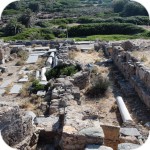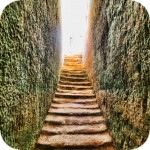

Polyrinia was one of the most important city-states of western Crete during the Hellenistic and Roman periods. It was built amphitheater on a steep hill, rising to a height of 481 meters above sea level

Most of the people who were in Crete heard of the great Minoan palaces, and a significant part certainly visited even Knossos. However, in addition to the famous grand palaces on the island in the Minoan period, a number of smaller residences were created. One of the most important examples is the Vathipetro discovered about 5 km north of Archanes, on the southeastern slope of Mount Juchtas in the central part of Crete.

Gortyna is considered one of the most extensive excavations in Greece. Currently, the ruins of the former capital of Crete occupy an area of approximately 400 hectares. You must be aware, however, that what is shared with our eyes is still only a small part of the treasures that this part of Crete conceals.

Redirected from the site - Paleokastro. Just over 2 km from Palekastro, next to Chiona beach, there is a large archaeological site called Roussolakos, which is worth visiting in this region of Crete.

Just over 2 km from Palekastro, next to Chiona beach, there is a large archaeological site called Roussolakos, which is worth visiting in this region of Crete.

On the north-western coast of Crete, at the foot of the Gramovous peninsula, there are ruins of the ancient port of Korikos, later known as Falassarna.

The ruins of the ancient city of Lissos are located about 3.5 km from Sougia on the southern coast of Crete and about 70 km southwest of the city of Chania in the place where Agios Kirikos is currently located. Lissos is one of those places that can be reached either on foot over a part of the E4 route or a rented boat.

The ruins of the ancient city of Itanos are located at the eastern tip of Crete, less than 3 kilometers north of the famous palm beach of Vai. Although there are also nice beaches at Itanos, unlike its well-known neighbor, this place does not attract crowds. There are either accidental stray tourists or excavation enthusiasts here.

11 km from the city of Sitia, near the modern village of Chamaizi, there is a small archaeological site. At the top of a cone-shaped hill called Souvloto Mouri, the remains of an unusual building with a unique oval shape were discovered. Despite its small size, it is one of the most important discoveries that comes from the Central Minoan period. So far, it is the only oval building from Crete in this period.

When, in 1960, heavy building equipment entered the small headland of Trypitos next to Sitia, no-one expected the land to hide the ruins of the ancient Hellenic city. To this day, this area is still being examined by archaeologists, and the found treasures feed the resources of the Archaeological Museum in Sitia. These niche excavations located just off the road to Vai are a must stop for any archeology enthusiast.

The Late-Romanesque cemetery in Armeni is located on the outskirts of this town, located less than 10 km south of the center of Rethymno. If you spend your holidays in this area, it is worth coming to this interesting archaeological site. Although it was discovered in 1969 by Yiannis Tzedakis, excavations are still carried out to this day.

Tylissos is one of the few places in Crete that has kept its name since ancient times. Between 1200 and 1000 BC, many settlements were abandoned by their inhabitants, who founded new villages in more inaccessible areas. Tylissos is an exception because it was inhabited all the time, thanks to which cultural continuity was maintained and the development of the religious center took place.

At present, the beginnings of settlement in this place date back to 1200 BC. Later, after 630 BC Azoria developed into a small town, whose population is estimated at between 2 and 5 thousand people.

The first Palace was built around 1900 BC in the place where there was a quite impressive settlement, whose remains were later transformed into the central part of the city. Very little is known about this palace, although some fragments of the floors and its walls have been preserved and encountered during works carried out in the younger buildings. This palace survived until 1700 BC when it was destroyed, and in its place the Second Palace was built, in many respects similar to the first one. It is its ruins that you can admire today, its end was laid in 1450 BC, when all the Minoan centers in Crete were destroyed.

About 60 kilometers southwest of the capital of Crete - Heraklion are the ruins of the second largest ancient palace - Phaistos. Visiting the various Minoan palaces of Crete, it is impossible not to compare them with each other, and in the case of Phaistos comparing it with the most famous Minoan Knossos imposes itself. In my opinion, it falls out of favor for the palace in Phaistos.

Agia Triada is a small Minoan archaeological site in the south of Crete, located near Timpaki, located on the western slope of the hill about 40 meters above sea level. To inquisitive tourists, the Christian name (Holy Trinity) of the Minoan position may seem at least strange, but this is only an expression of the ignorance of Italian archaeologists who were the first to discover this place. Not knowing what they found, they borrowed the name from a nearby abandoned village and gave it to excavations. The original name is still unknown. The first excavations were carried out at the beginning of the 19th century.
Redirected from the site - Káto Zákros (Ζάκρος). Zakros is the fourth-largest Minoan palace in Crete in importance and size. This latest found, built on the east coast of the island is located in the village of Káto Zákros. Rocky mountains surround the ruins of the palace complex with the remains of a once thriving city, built on a fairly hard-to-reach and inhabited area. Paradoxically, Zakros, being several centuries ago, a city with extensive contacts with other countries, was (and is actually still) the most isolated Minoan center on the island.
Zakros is the fourth-largest Minoan palace in Crete in importance and size. This latest found, built on the east coast of the island is located in the village of Káto Zákros. Rocky mountains surround the ruins of the palace complex with the remains of a once thriving city, built on a fairly hard-to-reach and inhabited area. Paradoxically, Zakros, being several centuries ago, a city with extensive contacts with other countries, was (and is actually still) the most isolated Minoan center on the island.
It is recognized that Gournia was inhabited between 3000 BC and 1200 BC and is one of the few cities unearthed to a large extent. In other major cities, archaeologists focused mainly on discovering palace buildings, while in Gournia, apart from the palace, urban buildings, residential houses and a road network were also discovered.

The ruins of the ancient city of LATO can be found near the charming village of Krista near Agios Nikolaos. This is one of my favorite excavations in Crete. Located on the sidelines, without crowds of crowds, exposed to the burning sun, which heats mercilessly the stone remains of the city. The atmosphere of isolation is conducive to such sightseeing that I prefer the most. It leaves room for both reverie over the former inhabitants of this place and a picturesque photographic plein-air without tourists entering the lens.

The name Aptera means no more or less without wings and is a direct reference to the legendary musical duel for which the Muses were challenged by Sirens, who were half-women and half-birds at the time. They did not have anyone in their territory who would be a worthy opponent in their singing and music. However, the duel with the Muses lost, and crushed by the result of the competition, they threw their wings and feathers to Soudha Bay. According to legends, today we can admire them as islands located at the mouth of the bay.

Knossos is one of the flagship monuments visited by tourists, it is also the most popular place where organized trips go. One of the more characteristic elements associated with the Knossos Palace is the red columns. Although they are currently made of concrete, they were originally made of cypress trunk.

